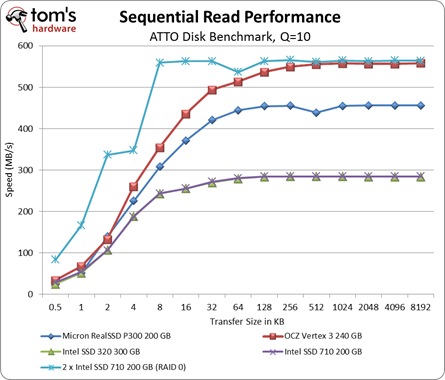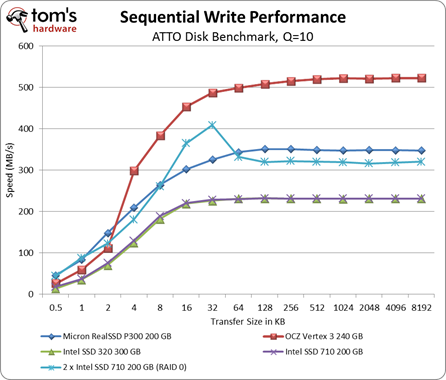Intel SSD 710 Tested: MLC NAND Flash Hits The Enterprise
Sequential Performance Versus Transfer Size
There are a number of enterprise-oriented workloads that push a lot of random data. Exchange information stores and online transaction processing are both good examples. Sequential tasks might include writing out log files or backing up data to disk. Either way, though, you're going to see more outstanding I/O operations using those applications than in a desktop environment, and that's why we're configuring ATTO to use its maximum queue depth of 10.
At high queue depths, RAID really delivers better performance at smaller transfer sizes. There is a performance overhead incurred with every page request (8 KB), so scaling up using striping is the only way to improve our results in that discipline.
While the RAID array stands apart in read operations, it's not as dominant in our write test; the SSD 710s deliver about ~40% more performance. In a single-drive configuration, the 710 continues to perform like the 320.
SandForce's compression technology really puts things into perspective, as the Vertex 3 leaves other SSDs in the dust at transfer sizes greater than 32 KB. It's the only SSD of the group to easily break through the 500 MB/s barrier, though it relies on the fact that ATTO uses compressible data (like log files) to achieve those numbers. Subject the same drive to incompressible data at the same queue depth and throughput drops to about 240 MB/s (using 128 KB blocks) instead.
Get Tom's Hardware's best news and in-depth reviews, straight to your inbox.
Current page: Sequential Performance Versus Transfer Size
Prev Page Benchmark Results: Enterprise Performance Next Page Performance Over Time
